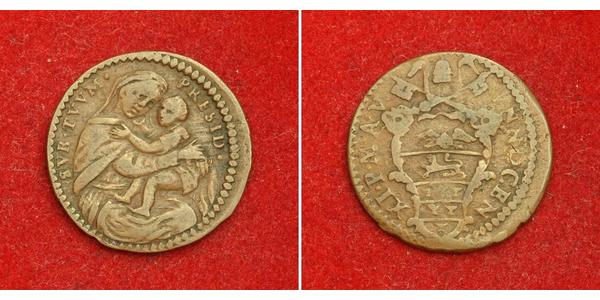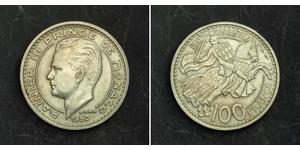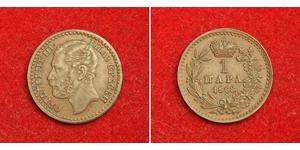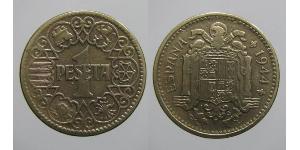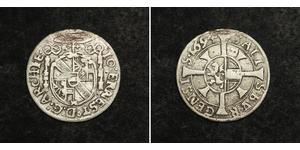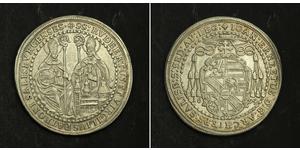(sold for $65.0)
1680, Vatican, Papal States, Gubbio, Pope Innocent XI. Copper Quattrino Coin. R!
Condition: VF+ Denomination: Quattrino Engraver: Giovanni Hamerani Mint Year: 1680 (regnal year V) Reference: KM-41 (1-year type!). Mint Place: Gubbio (City and papal state in the region of Umbria, Italy) Material: Copper Diameter: 22mm Weight: 3.73gm
Obverse: Half-length figure of the Virgin Mary and baby Jesus child. Legend: . SVB . TVVM . - PRESID . ("We fly to Thy protection... ...[O Holy Mother of God]") Reverse: Papal tiara and crossed keys above coat-of-arms of the Popel. Legend: INNOCEN - XI . P . M . A . V .
Beneath Thy Protection (Greek: Ὑπὸ τὴν σὴν εὐσπλαγχνίαν; Latin: Sub tuum præsidium) is the oldest preserved extant hymn to the Blessed Virgin Mary as Theotokos. The hymn is well known in many Roman Catholic, Eastern Orthodox and Oriental Orthodox countries, and is often a favourite song used along with Salve Regina.
Gubbio became part of the Papal States in 1631, when the family della Rovere, to whom the Duchy of Urbino had been granted, was extinguished. In 1860 Gubbio was incorporated into the Kingdom of Italy along with the rest of the Papal States.
Authenticity unconditionally guaraneed.
Pope Innocent XI (Latin: Innocentius PP. XI; Italian: Innocenzo XI; 16 May 1611 - 12 August 1689), born Benedetto Odescalchi, was the head of the Catholic Church from 21 September 1676 to his death in 1689.
Benedetto Odescalchi was born at Como in 1611 (either on 16 or 19 May), the son of a Como nobleman, Livio Odescalchi, and Paola Castelli Giovanelli from Gandino. In 1626 his father died, and Benedetto began schooling in human sciences taught by the Jesuits at his local college, before transferring to Genoa. In 1630 he narrowly survived an outbreak of plague, which killed his mother.
The Odescalchi family, although only of minor nobility, were nevertheless determined entrepreneurs. In 1619, Benedetto's brother founded a bank with his three uncles in Genoa which quickly grew into a successful money-lending business. After completing his studies in grammar and letters, the 15-year old Benedetto moved to Genoa to take part in the family business as an apprentice. Lucrative economic transactions were established with clients in the major Italian and European cities, such as Nuremberg, Milan, Kraków, and Rome.
Some time between 1632 and 1636, Benedetto decided to move to Rome and then Naples in order to study civil law. This led to securing the offices of protonotary apostolic, president of the apostolic chamber, commissary of the Marco di Roma, and governor of Macerata; on 6 March 1645, Pope Innocent X (1644-55) made him Cardinal-Deacon with the deaconry of Santi Cosma e Damiano. He subsequently became legate to Ferrara. When he was sent to Ferrara in order to assist the people stricken with a severe famine, the Pope introduced him to the people of Ferrara as the "father of the poor."
In 1650, Odescalchi became bishop of Novara, in which capacity he spent all the revenues of his see to relieve the poor and sick in his diocese. With the permission of the pope he resigned as bishop of Novara in favor of his brother Giulio in 1656 and went to Rome. While there he took a prominent part in the consultations of the various congregations of which he was a member.
Odescalchi was a strong papal candidate after the death of Pope Clement IX (1667-69) in 1669, but the French government rejected him (using the now-abolished veto). After Pope Clement X (1670-76) died, Louis XIV of France (1643-1715) again intended to use his royal influence against Odescalchi's election. Instead, believing that the cardinals as well as the Roman people were of one mind in their desire to have Odescalchi as their Pope, Louis reluctantly instructed the French party cardinals to acquiesce in his candidacy. On 21 September 1676, Odescalchi was chosen Clement X's successor and took the name of Innocent XI.
Immediately upon his accession, Innocent XI turned all his efforts towards reducing the expenses of the Curia. He passed strict ordinances against nepotism among the cardinals. He lived very parsimoniously and exhorted the cardinals to do the same. In this manner he not only squared the annual deficit which at his accession had reached the sum of 170,000 scudi, but within a few years the papal income was even in excess of the expenditures. He lost no time in declaring and practically manifesting his zeal as a reformer of manners and a corrector of administrative abuses. Beginning with the clergy, he sought to raise the laity also to a higher moral standard of living. He closed all of the theaters in Rome (considered to be centers of vice and immorality) and famously brought a temporary halt to the flourishing traditions of Roman opera. In 1679 he publicly condemned sixty-five propositions, taken chiefly from the writings of Escobar, Suarez and other casuists (mostly Jesuit casuists, who had been heavily attacked by Pascal in his Provincial Letters) as propositiones laxorum moralistarum and forbade anyone to teach them under penalty of excommunication. He condemned in particular the most radical form of mental reservation (stricte mentalis) which authorised deception without an outright lie.
Personally not unfriendly to Miguel de Molinos, Innocent XI nevertheless yielded to the enormous pressure brought to bear upon him to confirm in 1687 the judgement of the inquisitors by which sixty-eight quietist propositions of Molinos were condemned as blasphemous and heretical.
The pontificate of Innocent was marked by the struggle between the absolutism and hegemonic intentions of Louis XIV, and the primacy of the Catholic Church. As early as 1673, Louis had by his own power extended the right of the regale over the provinces of Languedoc, Guyenne, Provence, and Dauphine, where it had previously not been exercised.
All the efforts of Innocent to induce Louis XIV to respect the rights and primacy of the Church proved useless. In 1682, the King convoked an assembly of the French clergy which adopted the four articles that became known as the Gallican Liberties. Innocent XI annulled the four articles on 11 April 1682, and refused his approbation to all future episcopal candidates who had taken part in the assembly.
To appease the Pope, Louis began to act as a zealot of Catholicism. In 1685 he revoked the Edict of Nantes and inaugurated a persecution of French Hugenots. Innocent expressed displeasure at these drastic measures and continued to withhold his approbation from the episcopal candidates.
Innocent irritated the King still more that same year by abolishing the much abused right of asylum, by which foreign ambassadors in Rome had been able to harbor in embassies any criminal wanted by the papal court of justice. He notified the new French ambassador, Marquis de Lavardin, that he would not be recognised as ambassador in Rome unless he renounced this right, but Louis XIV would not give it up. At the head of an armed force of about 800 men Lavardin entered Rome in November 1687, and took forcible possession of his palace. Innocent XI treated him as excommunicated and placed under interdict the Church of St. Louis at Rome where he attended services on 24 December 1687.
In January 1688, Innocent also received the diplomatic mission which had been dispatched to France and the Vatican by Narai, the King of Siam under Fr. Guy Tachard and Ok-khun Chamnan in order to establish relations.
The tension between the Pope and the King of France increased by Innocent's procedure in filling the vacant archiepiscopal see of Cologne. The two candidates for the see were Cardinal William Egon of Fürstenberg, then Bishop of Strasbourg, and Joseph Clement, a brother of Max Emanuel, Elector of Bavaria. The former was a willing tool in the hands of Louis XIV, and his appointment as Archbishop and Prince-elector of Cologne would have implied French preponderance in north-western Germany.
Joseph Clement was not only the candidate of Emperor Leopold I (1658-1705) but of all European rulers, with the exception of the King of France and his supporter, King James II of England (1685-88). At the election, which took place on 19 July 1688, neither of the candidates received the required number of votes. The decision, therefore, fell to Innocent, who designated Joseph Clement as Archbishop and Elector of Cologne.
Louis XIV retaliated by taking possession of the papal territory of Avignon, imprisoning the papal nuncio and appealing to a general council. Nor did he conceal his intention to separate the French Church entirely from Rome. The Pope remained firm. The subsequent fall of James II in England destroyed French preponderance in Europe and soon after Innocent XI's death the struggle between Louis XIV and the papacy was settled in favour of the Church.
Innocent XI dispatched Ferdinando d'Adda as nuncio to the Kingdom of England, the first representative of the Papacy to go to England for over a century. Even so, the Pope did not approve the imprudent manner in which James II attempted to restore Catholicism in England. He also repeatedly expressed his displeasure at the support which James II gave to the autocratic King Louis XIV in his measures against the Church. It is, therefore, not surprising that Innocent XI had little sympathy for James, and that he did not afford him help in his hour of trial.
In 2007, married couple writer duo Rita Monaldi and Francesco Sorti, drew some media attention to the claim, that Innocent XI had secretly funded the resistance of the Protestant hero William of Orange to the French King, and even financed his overthrow of James II of England; in their novelized vision this was done using the established Odescalchi family business in money-lending. But this theory lack of historical evidence. In fact, on the one hand, it does not consider the bad relationship between Papal State and France, and on the other hand, it underestimates the good relationship between France and James II. As Roman Catholic Pope, Innocent XI was concerned to defend the Primacy of the Bishop of Rome against the Louis XIV Gallicanism. Innocent XI financial support to William of Orange was solely attempting to avoid any schismatic aspiration of Louis XIV and the rejection of Ultramontanism in England by James II.
Innocent XI died after a long period of ill health on 12 August 1689. Following his death, he was buried in St Peter's Basilica beneath his funeral monument near the Clementine Chapel, which his nephew, Livio Odescalchi, commissioned. The monument, which was designed and sculpted by Pierre-Étienne Monnot, features the pope seated upon the throne above a sarcophagus with a base-relief showing the liberation of Vienna from the Turks by John III Sobieski, flanked by two allegorical figures representing Faith and Fortitude.
The process of Innocent's beatification was introduced in 1741 by Benedict XIV and continued by Clement XI and Clement XII; but French influence and the accusation of Jansenism caused it to be suspended in 1744. In the 20th century it was reintroduced, and Venerable Pope Pius XII (1939-58) announced his beatification on 7 October 1956.
When his body was exhumed for beatification, it was discovered that it had remained preserved, though 267 years had passed since his death. Innocent XI was subsequently considered by many to be incorrupt, and his body was placed in a glass and bronze-work sarcophagus with his face and hands covered in silver. He is regarded by many Catholics to be the first Pope whose body was discovered to be incorrupt, followed by Pope St. Pius X (1903-14) and Pope John XXIII (1958-63).
Following his beatification, his sarcophagus was placed under the Altar of St. Sebastian in the basilica's Chapel of St. Sebastian, where it remained until 8 April 2011 when it was moved to make way for the remains of Pope John Paul II (1978-2005) to be relocated to the basilica from the grotto beneath St. Peter's in honor of his beatification and in order to make his resting place more accessible to the public. Innocent's body was transferred to the basilica's Altar of Transfiguration, which is located near the Clementine Chapel and the entombed remains of Pope St. Gregory the Great (590-604). The altar is also across from Innocent XI's monument, which was his original site of burial before his beatification.
The feast day of Pope Innocent XI is 12 August, the date of his death.
Only 1$ shipping for each additional item purchased!

|
Posted by:
anonymous 2016-12-06 |
1/2 Thaler Salzburg Silver
group has 16 coins / 12 prices
⇑

